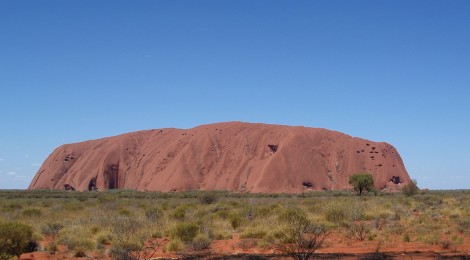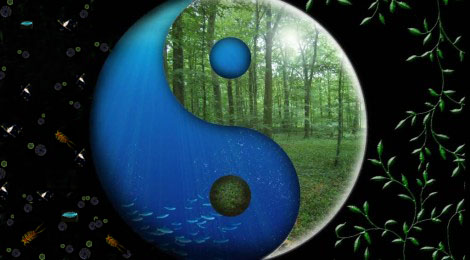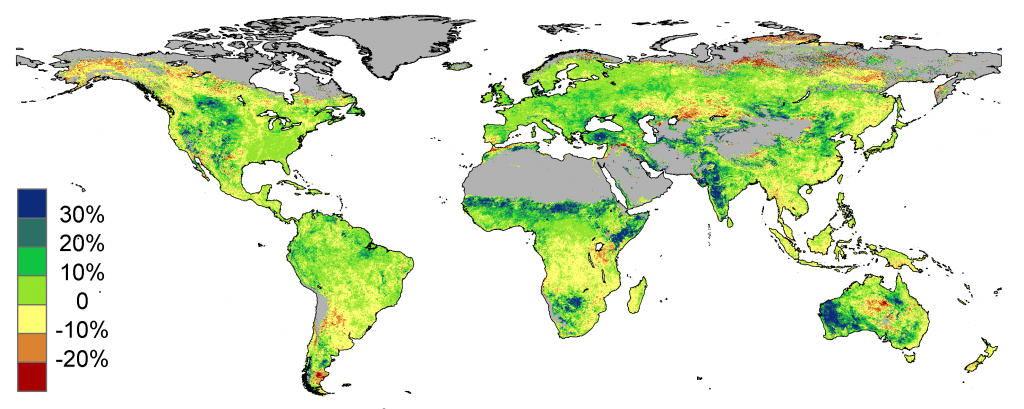
Global Greening
Rising atmospheric carbon dioxide levels are producing a global greening of terrestrial plant life around the world while eradicating ocean plants.
More grass growing means less dust blowing, dust that is vital to ocean plant life
Ocean pastures are becoming clear blue deserts
A new peer-reviewed study, published in Geophysical Research Letters (July 2013), using data gleaned from satellite measurements of global plant life strongly contradicts assertions by many that global warming is causing deserts to expand, along with devastating droughts.
Randall Donohue, a research scientist at the Commonwealth Scientific and Industrial Research Organization in Australia and his team analyzed satellite data from 1982 through 2010. They show a potent carbon dioxide “fertilization effect” has resulted in a gradual and dramatic global greening of the Earth, and particularly the Earth’s arid grassland regions, since 1982.
This is good news for the planet but there is a catch.
More Grass Growing Means Less Dust Blowing Resulting In A Worsening Drought Of Minerals For Ocean Pastures

Rain and Dust in the wind are the Yin and Yang for pastures on land and at sea. Grass on our terrestrial pastures needs rain to thrive, phytoplankton, the grass of ocean pastures, must receive dust to thrive. Click image to read more…
All plants whether growing on land or in the ocean have just two most critical requirements, they need minerals, and they need water. This is where the world of plants on this blue planet splits in two.
The plants on land have all of the minerals they need, they are stuck in it, in the dirt. The plants in the oceans have all of the water they need, they are stuck in it, in the water.
The work reported in this recent GRL publication provides extensive satellite data corroborated with land-based measurements that show rising CO2 levels caused a remarkable 11 percent increase in foliage in arid regions in just 30 years as compared to what might have been the case if atmospheric carbon dioxide levels had remained at 1982 levels.
“Lots of papers have shown an average increase in vegetation across the globe, and there is a lot of speculation about what’s causing that,” Donohue said in a press release accompanying the study. “Up until this point, they’ve linked the greening to fairly obvious climatic variables, such as a rise in temperature where it is normally cold or a rise in rainfall where it is normally dry. Lots of those papers speculated about the CO2 effect, but it has been very difficult to prove.”
Listen to dr. Donohue in this CSIRO Podcast
The study noted that foliage in warm, wet regions such as tropical rain-forests are near their maximum capacity. However, in warm, arid regions there is the capacity for greater increases in foliage and there they show rising carbon dioxide levels is inducing more plant growth.
Carbon dioxide acts helps plants grow and stay green. “Our work was able to tease-out the CO2 fertilization effect by using mathematical modelling together with satellite data adjusted to take out the observed effects of other influences such as precipitation, air temperature, the amount of light, and land-use changes.”
The fertilization effect occurs where elevated CO2 enables a leaf during photosynthesis, the process by which green plants convert sunlight into sugar, to extract more carbon from the air or lose less water to the air, or both.
If elevated CO2 causes the water use of individual leaves to drop, plants in arid environments will respond by increasing their total numbers of leaves. These changes in leaf cover can be detected by satellite, particularly in deserts and savannas where the cover is less complete than in wet locations, according to Dr. Donohue.ts thrive under arid conditions. Although global precipitation has increased during the past century as the Earth has warmed, elevated carbon dioxide levels are assisting plant life in warm, dry regions independent of – and in addition to – increases in global precipitation.
“The effect of higher carbon dioxide levels on plant function is an important process that needs greater consideration,” said Donohue. “Even if nothing else in the climate changes as global CO2 levels rise, we will still see significant environmental changes because of the CO2 fertilization effect.”
Donohue focused special attention on Australia in an additional press release. Although global drought is becoming less frequent and less severe as the Earth modestly warms, activists claim global warming is causing harmful drought in Australia.
“In Australia, our native vegetation is superbly adapted to surviving in arid environments and it consequently uses water very efficiently,” said Donohue. “Australian vegetation seems quite sensitive to CO2 fertilization.”
“On the face of it, elevated CO2 boosting the foliage in dry country is good news and could assist forestry and agriculture in such areas,” Donohue reported while adding that scientists should still monitor secondary effects.
The satellite data show plant life in the United States has especially benefited from rising atmospheric carbon dioxide levels and gradually warming temperatures. Satellite data show foliage has increased in the vast majority of the United States since 1982, with the western U.S. benefiting the most. Indeed, many western regions experienced a greater than 30 percent increase in foliage since 1982.
Other regions showing particularly strong increases in foliage include the Sahel region of Africa, the Horn of Africa, southern Africa, the Indian subcontinent, and nearly all of Europe.
For more on how CO2 is producing “global greening.”
CO2 PROMOTES GROUND COVER VIA TRANSPIRATION WATER LOSS REDUCTIONS
And for a twist of fate Hawaiian rainforests depend on Gobi dust for their growth.









